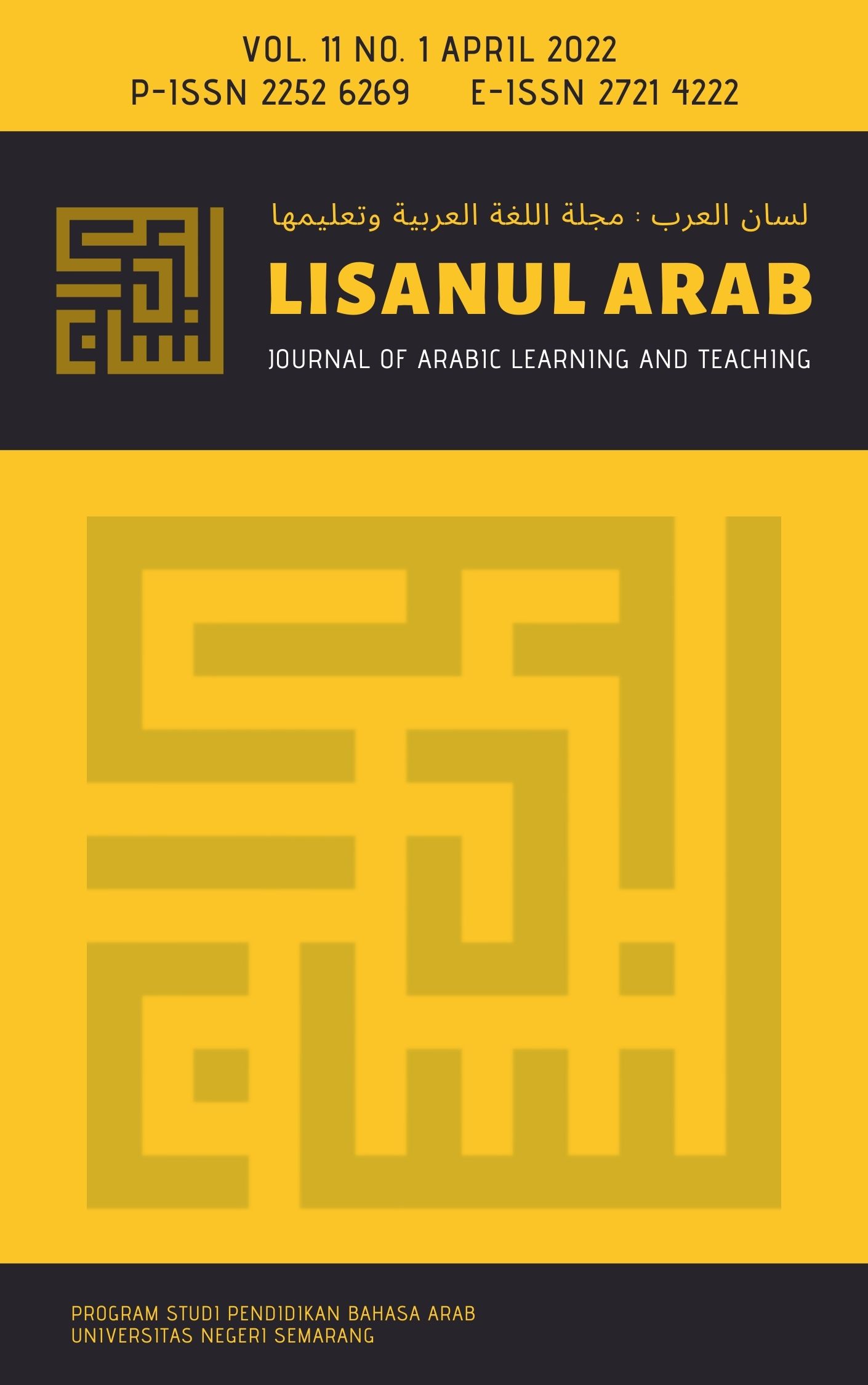ISM AL-MA’RIFAH (NOMINA DEFINIT) BERKASUS NASBH (AKUSATIF) DALAM AL-QUR’AN SURAT AL-BAQARAH ISM AL-MA’RIFAH (ACCOUSATIVE DEFINIT NOUN) IN AL-QUR’AN SURAH AL-BAQARAH Section Articles
##plugins.themes.academic_pro.article.main##
Abstract
This study aims to determine the types, functions, and grammatical markers of ism ma'rifah in the accusative case in Surah al-Baqarah. This research is a qualitative research with library research design. The data of this research are the ism ma'rifah in the accusative case that comes from surah al-Baqarah. The data collection technique used the watch-note technique and the instruments used were the researchers themselves, data cards, and recapitulation sheet. The data analysis technique used the distributional method with the technique for direct elemental. Of the 100 data samples analyzed by the researcher based on their type, it was found 7 data type of ism 'alam, 34 data type of ism dhamir, 15 data type of ism maushul, 1 data type of ism isyarah, 19 data type of ism al-ma'rifah with the particle Alif lam (ال), 19 data type of ism al-ma'rifah with idhafah construction, and 5 data are of the type of ism al-ma'rifah with nida particles. Based on the syntactic function, it is found that 1 data functions as khabar Kana, 18 data functions as isim inna, 62 data functions as maf'ul bih, 1 data functions as maf'ul muthlaq, 1 data functions as maf'ul li ajlih, 1 data functions as mustastna, 5 data functions as munada, 1 data functions as chal, 5 data functions as na’at, 3 data functions as ma'thuf, 1 data functions as badal. Based on the grammatical markers, it was found that 38 data had the grammatical marker fathah, 1 data had the grammatical marker kasrah, 3 data had the grammatical marker ya', 5 data had the grammatical marker fathah muqoddarah and 53 data had the grammatical marker mabniy fii machal an-nasbiy.
##plugins.themes.academic_pro.article.details##
References
Al-Habsyi, A. Z. A. (2020). Rahasia Nama dan Sifat Al-Qur’an. Rayyana.
Ardiani, I. T., Kuswardono, S., & Hasyim, M. Y. (2019). Kesalahan Penerjemahan Teks Bahasa Indonesia ke Bahasa Arab Melalui Imtraslator (Analisis Geamatikal). Lisanul Arab, 8, 34–49.
Arrsayid, R. B. (2017). Isim Ma’rifat Berkasus Nominatif pada Buku Tazkiyatu Al Nufus (Analisis Sintaksis). Universitas Negeri Semarang.
Baryadi, I. P. (2020). Teori Linguistik Sesudah Strukturalisme. Santa Darma University Press.
Fadilah, N. A., Busri, H., & Zukhaira. (2019). Mubtada (Topic) Isim Nakirah (Nomina Indenfinit) Dalam Fath Al-Qarib Al-Mujib (Analisis Sintaksis). Lisanul’ Arab: Journal of Arabic Learning and Teaching, 8(2), 111–115.
Hasyimi, A. (2020). Al-Qowaidul Asasiyyah Lil Lughoh Ai-Arabiyyah. Dar Al-Kotob Al-Ilmiyah.
Humaini, A. (2017). Penanda Jamak (Perbandinan Antara Bahasa Arab dan Bahasa Indonesia). Al-Mahara, 3(2), 255–268.
Kuswardono, S. (2018). Handout Muqaddimah fi Ilmi Nahwi. UNNES.
Musthofiyah, A., Miftahuddin, A., & Azmi Amrullah, N. (2020). AYYUN DALAM AL-QUR’AN (ANALISIS SINTAKSIS) Anis. Lisanul Arab, 9(1), 1–8.
Naefiroja, A., Hasyim, M. Y. A., & Kuswardono, S. (2021). Al Asma Al Mabniyyah Dalam Buku Maulid Al Barzanji Natsran Karya Syaikh Ja’Far Bin Hasan Bin Abdul Karim Al Barzanji (Analisis Sintaksis). Lisanul Arab: Journal of Arabic Learning and Teaching, 10(1), 23–26. https://doi.org/10.15294/la.v10i1.48207
Nikma, F. (2018). Panduan Lengkap Belajar Bahasa Arab. Turos.
Purnawati, K. W., Artawa, K., & Krisnawati, N. L. P. (2021). Strategi pemarkahan kedefinitan dalam Bahasa Indonesia. Aksara, 33(1). https://doi.org/10.29255/aksara.v33il.563.hlm.
Rochbani. (2013). Kasus Genetif (Majrurot Al-Asma) Dalam Surat Yasin. Lisanul’ Arab: Journal of Arabic Learning and Teaching, 2(1), 33–37.
Zahroh, L. (2017). Isim Al-Ma’rifah (Nomina Definit) dalam Buku Ta’lîm Al-Lughah Al-‘Arabiyyah Lighair Al-‘Arab (Analisis Sintaksis). Universitas Negeri Semarang.
